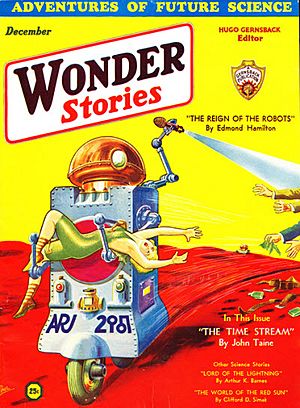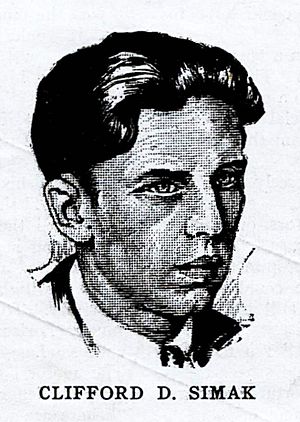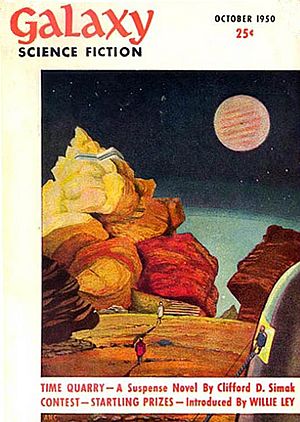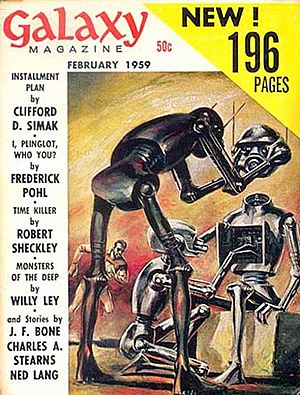Clifford D. Simak facts for kids
Quick facts for kids
Clifford D. Simak
|
|
|---|---|
 |
|
| Born | Clifford Donald Simak August 3, 1904 Millville, Wisconsin, U.S. |
| Died | April 25, 1988 (aged 83) Minneapolis, Minnesota, U.S. |
| Occupation | Journalist, popular writer |
| Alma mater | University of Wisconsin–Madison |
| Period | 1931–1986 (fiction) |
| Genre | Science fiction, fantasy |
| Subject | Popular science |
| Notable works |
|


Clifford Donald Simak (pronounced SIM-ack; born August 3, 1904 – died April 25, 1988) was an American writer. He was famous for his science fiction and fantasy stories. Simak won many important awards for his writing, including three Hugo Awards and one Nebula Award. He was also named a SFWA Grand Master by the Science Fiction Writers of America. This is a very special honor for science fiction writers.
About Clifford Simak
Early Life and Career
Clifford Simak was born in Millville, Wisconsin, in 1904. His parents were John Lewis and Margaret Simak. He went to the University of Wisconsin–Madison. After college, he worked as a teacher for a few years.
Later, Simak became a journalist. He worked for different newspapers in the Midwest. In 1939, he started working at the Minneapolis Star and Tribune newspaper in Minneapolis, Minnesota. He stayed there until he retired in 1976. He became the news editor in 1949.
Family Life
Clifford Simak married Agnes Kuchenberg in 1929. They had two children, Richard and Shelley. Simak loved fishing, playing chess, collecting stamps, and growing roses. He was known to be a kind person and was well-liked by other science fiction writers, like Isaac Asimov. He passed away in Minneapolis in 1988.
Clifford Simak's Writing Journey


Clifford Simak became interested in science fiction when he was a child. He enjoyed reading books by H. G. Wells. His first science fiction story, "The World of the Red Sun," was published in 1931.
He wrote several stories in the early 1930s. Then, he took a break from science fiction for a few years. He returned to writing science fiction in 1938 when John W. Campbell became the editor of Astounding Science Fiction magazine. Simak became a regular writer for this magazine during the "Golden Age of Science Fiction" (1938–1950).
At first, he wrote adventure-filled "super science" stories. But soon, he developed his own special style. His stories were often described as gentle and focused on nature. During this time, he also wrote war and western stories for other magazines.
One of his most famous books is City. This book is made up of several short stories that are connected. They tell a story about humans eventually leaving Earth. Simak kept writing popular novels throughout the 1950s and 1960s. He continued writing science fiction and fantasy into his 80s.
Simak believed that science fiction should be based on scientific facts. He wanted the genre to be taken seriously, like other types of "realistic fiction."
What Simak Wrote About
Rural Settings and Unique Characters
Simak's stories often take place in the countryside. This is why his writing style is sometimes called "pastoral." You'll often find tough, independent characters from the woods, like Hiram Taine in "The Big Front Yard." Hiram's dog, "Towser" (or sometimes "Bowser"), appears in many of Simak's books.
His alien characters often have a funny, unusual sense of humor. His robots are full of personality, and even the dogs in his stories seem very real. Unlike some writers, Simak's main human characters are often quite ordinary.
Quests and Journeys
Many of Simak's stories involve a quest or a special mission. Characters often start alone and then meet unusual companions along their journey. Some characters might leave the group, while others rejoin later.
Time Travel and Other Worlds
Simak's stories often explore interesting ideas about time travel. He suggests that going to a different time means going to a different world. For example, in City, when Earth is taken over by ants, the intelligent dogs and remaining humans escape to other worlds in the time stream.
In Ring Around the Sun, people with special powers escape to other Earths. These Earths are at different points in their orbit around the sun, which gives the book its title. In Time Is the Simplest Thing, a person escapes a crowd by going back in time. But they find that the past is a place with no living things.
Time travel is also important in Time and Again. A space traveler returns with a strange message that mixes science fiction with religious ideas. This message causes problems on Earth and almost leads to war.
Robots and Big Questions
Simak often used robots in his stories to explore deep questions. These robots act like "substitute humans." They start as friendly mechanical beings but change in surprising ways. Once they become intelligent, they start asking big questions like, "Why are we here?" and "Do robots have souls?"
Examples include the loyal robot butler Jenkins in City, the religious robot Hezekiel in A Choice of Gods, and the monk-like robots in Project Pope who search for heaven.
In All the Traps of Earth, a 600-year-old robot named Richard Daniel is considered property. He runs away and gains special powers to fix things. He finds a purpose helping pioneers on a new planet. Simak shows how robots, created by humans, can develop amazing abilities that help humanity. This is how robots, and humans, escape "all the traps of earth."
Religious Themes
Religious ideas often appear in Simak's work. However, characters who look for God in a traditional way often find something more abstract and less human. For example, Hezekiel in A Choice of Gods struggles with this idea.
Different Story Styles
Simak wrote both thoughtful, peaceful stories and ones that were quite scary. He also wrote humorous stories, like "The Big Front Yard." His novel Way Station is a deep look into a lonely man's mind. It shows how he comes to terms with his past.
Simak also explored other common science fiction themes. These include the importance of knowledge and kindness, identity, and machines rebelling. He often included strange alien creatures or concepts that his characters could not fully understand.
In the introduction to his collection Skirmish, Simak summed up his writing. He said he avoided big alien invasions or space wars. Instead, he focused on people and wrote in a quiet way, with little violence. He often struck a hopeful note. He tried to speak for decency, compassion, and understanding. He wanted to place humans in perspective against the vastness of the universe. He wondered where humanity was going and what our purpose might be. He believed we do have a purpose, and perhaps an important one.
Clifford Simak's Books and Stories
Clifford Simak wrote more than 30 novels and four non-fiction books between 1950 and 1986. His novel Way Station won the Hugo Award in 1964.
He also published over 100 short stories from 1931 to 1981. These stories were in science fiction, western, and war genres. His short story "The Big Front Yard" won the Hugo Award in 1959. "Grotto of the Dancing Deer" won both the Hugo and Nebula Awards in 1981.
One of his short stories, "Good Night, Mr. James," was made into a TV episode called "The Duplicate Man" for The Outer Limits in 1964. Simak noted that this was a "vicious story" and the only one of his adapted for television.
Awards and Special Recognitions
Clifford Simak received many awards for his contributions to science fiction:
- In 1977, the Science Fiction Writers of America named him its third SFWA Grand Master. This is a very high honor, given to writers who have made a huge impact on science fiction.
- In 1987, the Horror Writers Association gave him one of their first Bram Stoker Award for Lifetime Achievement awards.
- An asteroid, 228883 Cliffsimak, was named after him in 2010.
Here are some of his other awards:
- Minnesota Academy of Science Award for distinguished service to science (1967)
- First Fandom Hall of Fame award (1973)
- Retro Hugo for best novelette, “Rule 18” (1938)
- Retro Hugo for best novelette, "City" (1944)
- International Fantasy Award for best fiction book (1953) for City
- Hugo Award for best novelette (1959) for "The Big Front Yard"
- Hugo Award for best novel (1964) for Way Station
- Jupiter Award for best novel (1978) for A Heritage of Stars
- Hugo Award for best short story (1981) for "Grotto of the Dancing Deer"
- Nebula Award for best short story (1981) for "Grotto of the Dancing Deer"
- Locus Award for best short story (1981) for "Grotto of the Dancing Deer"
- Analytical Laboratory award for best short story (1981) for "Grotto of the Dancing Deer"
See also
 In Spanish: Clifford D. Simak para niños
In Spanish: Clifford D. Simak para niños
Images for kids


